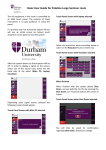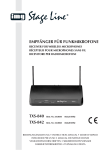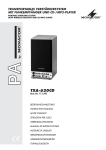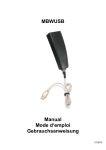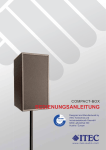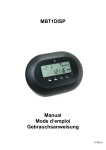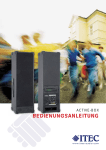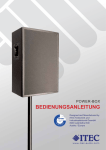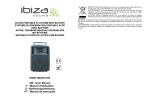Download SPEECH-200 (SPEECH200)
Transcript
REDNERPULT MIT VERSTÄRKERSYSTEM LECTERN WITH AMPLIFIER SYSTEM SPEECH -200 Best.-Nr. 17.3160 BEDIENUNGSANLEITUNG INSTRUCTION MANUAL 1 2 3 17 1 MIC 1 VOLUME 12 RF +12 0 10 XLR (PHANTOM) MICROPHONE INPUT JACK - LINE MONO 2 2 1 1 3 3 1 VOLUME +12 12 RF 12 MICROPHONE INPUT JACK - LINE MONO +7 7 7 +7 +12 12 0 XLR +7 7 12 +12 +12 SPEECH-200 10 MICROPHONE INPUT JACK - LINE MONO 2 2 1 1 3 3 0 7 PROFESSIONAL LECTERN 10 +7 AUDIO IN 12 +12 LINE OUT REC LIMITER POWER SPEECH-200 10 MICROPHONE INPUT JACK - LINE MONO 1 1 3 3 +12 12 0 XLR MICROPHONE INPUT JACK - LINE MONO 2 2 VOLUME +12 0 10 XLR (PHANTOM) +12 12 RF VOLUME 4 VOLUME RF 0 10 XLR (PHANTOM) MICROPHONE INPUT JACK - LINE MONO 3 2 MIC 2 VOLUME +7 4 VOLUME 0 10 XLR (PHANTOM) 7 12 MIC 1 3 2 MIC 2 VOLUME 0 7 PROFESSIONAL LECTERN 10 +7 AUDIO IN 2 1 2 3 +12 12 5 6 1 2 3 7 1 3 12 +12 12 LINE OUT REC +12 8 9 10 LIMITER POWER 18 11 12 18 13 POWER POWER 19 230 V~ / 50 Hz /180 /180VA VA F1AL FREQUENCY 863.05 MHz 230 V~ / 50 Hz /180VA F1AL FREQUENCY 863.05 MHz 14 15 16 2 4 D Bevor Sie einschalten … Wir wünschen Ihnen viel Spaß mit Ihrem neuen Gerät von MONACOR. Bitte lesen Sie diese Bedienungsanleitung vor dem CH Betrieb gründlich durch. Nur so lernen Sie alle Funktionsmöglichkeiten kennen, vermeiden Fehlbedienungen und schützen sich und Ihr Gerät vor eventuellen Schäden durch unsachgemäßen Gebrauch. Heben Sie die Anleitung für ein späteres Nachlesen auf. Der deutsche Text beginnt auf der Seite 4. A GB Before switching on … We wish you much pleasure with your new MONACOR unit. Please read these operating instructions carefully prior to operating the unit. Thus, you will get to know all functions of the unit, operating errors will be prevented, and yourself and the unit will be protected against any damage caused by improper use. Please keep the operating instructions for later use. The English text starts on page 6. 3 D A Auf der Seite 2 finden Sie alle beschriebenen Bedienelemente und Anschlüsse. CH 1 Übersicht der Bedienelemente und Anschlüsse 1 Eingang MIC 1 als XLR-Buchse mit 24-VPhantomspeisung zum Anschluss eines Mikrofons an den Eingangskanal 1 [alternativ zum Anschluss (7) auf der Rückseite] 2 Pultbeleuchtung 3 Schalter für die Pultbeleuchtung (2 Helligkeitsstufen) 2 Hinweise für den sicheren Gebrauch 4 Gerät transportieren und aufstellen Das Gerät entspricht allen relevanten Richtlinien der EU und ist deshalb mit gekennzeichnet. Zum Transportieren das Rednerpult am Oberteil anfassen und leicht nach hinten kippen, so dass es nur auf den beiden Rollen steht. Es kann so bequem zum Einsatzort gefahren werden. Das Gerät so aufstellen, dass die Lautsprecher auf der Vorderseite des Pultes auf das Publikum gerichtet sind. WARNUNG Das Gerät wird mit lebensgefährlicher Netzspannung versorgt. Nehmen Sie deshalb niemals selbst Eingriffe am Gerät vor. Es besteht die Gefahr eines elektrischen Schlages. Beachten Sie auch unbedingt die folgenden Punkte: G Das Gerät ist nur zur Verwendung im Innenbereich geeignet. Schützen Sie es vor Tropfund Spritzwasser, hoher Luftfeuchtigkeit und Hitze (zulässiger Einsatztemperaturbereich 0 – 40 °C). G Nehmen Sie das Gerät nicht in Betrieb und ziehen Sie sofort den Netzstecker aus der Steckdose, 1. wenn sichtbare Schäden am Gerät oder am Netzkabel vorhanden sind, 2. wenn nach einem Sturz oder Ähnlichem der Verdacht auf einen Defekt besteht, 3. wenn Funktionsstörungen auftreten. Geben Sie das Gerät in jedem Fall zur Reparatur in eine Fachwerkstatt. G Ziehen Sie den Netzstecker nie am Kabel aus der Steckdose, fassen Sie immer am Stecker an. G Verwenden Sie für die Reinigung nur ein trockenes, weiches Tuch, niemals Wasser oder Chemikalien. G Wird das Gerät zweckentfremdet, nicht richtig angeschlossen, falsch bedient oder nicht fachgerecht repariert, kann keine Haftung für daraus resultierende Sach- oder Personenschäden und keine Garantie für das Gerät übernommen werden. 4 Eingang MIC 2 als XLR-Buchse mit 24-VPhantomspeisung zum Anschluss eines Mikrofons an den Eingangskanal 2 (alternativ zum Anschluss auf der Rückseite) 5 Lautstärkeregler VOLUME jeweils für die Eingangskanäle 1 – 4 6 LED RF; leuchtet, wenn ein Funksignal am Eingangskanal 1 empfangen wird Das Signal von einem Funkmikrofon wird einem Signal am Eingang von Kanal 1 dazugemischt. Die LED RF am Eingangskanal 2 ist ohne Funktion. 7 kombinierte XLR-/ Klinkenbuchse zum Anschluss eines Mikrofons über einen XLR-Stecker oder einer Signalquelle mit Line-Pegel über einen zweipoligen 6,3-mm-Klinkenstecker jeweils für die Eingangskanäle 1 – 3 Die XLR-Kontakte der Eingangskanäle 1 und 2 sind mit einer Phantomspeisung (24 V), z. B. für Elektretmikrofone, ausgestattet. 8 Klangregler HIGH, MID und LOW, jeweils für die Kanäle 1 – 3 9 Cinch-Eingänge AUDIO IN zum Anschluss einer Signalquelle mit Line-Pegel an den Eingangskanal 4; beim Anschluss beider Buchsen (z. B. Stereosignal von einem CD-Spieler) wird aus den Signalen die Summe (Mono) gebildet 10 Ausgang LINE OUT, REC als Cinch-Buchsen zum Weiterleiten des Mischsignals z. B. zu einem Aufnahmegerät oder einem weiteren Verstärkersystem 11 LED LIMITER leuchtet, wenn der Eingangspegel zu hoch ist und vom Limiter begrenzt wird 12 Betriebsanzeige POWER 13 Netzschalter POWER 14 Netzbuchse zum Anschluss an eine Steckdose (230 V~/50 Hz) über das beiliegende Netzkabel 15 Halterung für die Netzsicherung Eine geschmolzene Sicherung nur durch eine gleichen Typs ersetzen! 16 Transportrollen 17 Ablagefach, z. B. für Schreibstifte oder ein Gerät zur Tonaufnahme oder -wiedergabe 18 Ablagefächer, z. B. für Vortragsunterlagen und diese Bedienungsanleitung 19 Staufach, z. B. für Anschlusskabel 4 Soll das Gerät endgültig aus dem Betrieb genommen werden, übergeben Sie es zur umweltgerechten Entsorgung einem örtlichen Recyclingbetrieb. 3 Einsatzmöglichkeiten Das Rednerpult SPEECH-200 besteht aus einem hochwertigen 2-Wege-Lautsprechersystem, einem Mischverstärker mit vier Eingangskanälen und einem Empfangsteil für ein Funkmikrofon mit 863,05 MHz Trägerfrequenz. Es dient zur Beschallung bei Vorträgen, Ansprachen, Lesungen etc., wobei das optionale Funkmikrofon eine zusätzliche Mobilität bietet (z. B. kann es für Rückfragen im Publikum herumgereicht werden). Neben drei Mikrofonen lassen sich auch andere Audiogeräte (z. B. CD-Spieler für Musikeinspielungen) anschließen. Über den Anschluss LINE OUT, REC kann das Ausgangssignal zu einem Aufnahmegerät oder zu einem anderen Verstärkersystem weitergeleitet werden. Die integrierte Beleuchtung der Auflagefläche kann in zwei Helligkeitsstufen eingeschaltet werden. Durch die beiden eingebauten Rollen an der Rückseite lässt sich das Pult bequem transportieren. 5 Anschlüsse herstellen Vor dem Anschließen von Geräten oder dem Ändern bestehender Anschlüsse das Verstärkersystem und die anzuschließenden Geräte ausschalten. 5.1 Mikrofone und Audiogerät 1) Ein Mikrofon (z. B. ein passendes Schwanenhalsmikrofon aus der EMG...P-Serie) auf eine der XLR-Buchsen (1 oder 4) auf der Pultoberseite stecken und auf den Sprecher ausrichten. Es können auch beide Buchsen mit je einem Mikrofon versehen werden. Die Buchsen besitzen eine Verriegelung. Zum Herausziehen eines Steckers den PUSHHebel drücken. Alternativ kann ein Mikrofon mit einem XLR-Stecker auch an die Eingangsbuchse (7) der Kanäle 1 und 2 auf der Pultrückseite angeschlossen werden. Diese Mikrofoneingänge stellen, wie auch die Buchsen auf der Pultoberseite, die von einigen Mikrofonen benötigte Phantomspeisung (24 V ) zur Verfügung. Ein weiteres Mikrofon kann mit einem XLR-Stecker an die Eingangsbuchse von Kanal 3 angeschlossen werden. 2) Zum Anschluss einer Signalquelle mit LinePegel (z. B. Mischpult, CD-Spieler) können die Klinkenbuchsen (7) der Eingangskanäle 1 – 3 (wenn der jeweilige Kanal noch nicht durch ein Mikrofon belegt ist) oder die CinchBuchsen AUDIO IN (9) von Kanal 4 genutzt werden. Beim Anschluss beider Cinch-Buchsen (z. B. Stereosignal von einem CD-Spieler) wird aus den Signalen die Summe (Mono) gebildet. Hinweis: Bei Verwendung eines Funkmikrofons wird dessen Signal zum Eingangssignal von Kanal 1 hinzugemischt. 5.2 Aufnahmegerät oder zusätzliches Verstärkersystem An die Cinch-Buchsen des Ausgangs LINE OUT, REC (10) kann ein Aufnahmegerät oder ein weiteres Audiogerät mit Line-Eingang angeschlossen werden (z. B. ein zusätzliches Verstärkersystem zur Beschallung eines größeren Bereichs). Hier steht das Mischsignal der Tonquellen zur Verfügung. 5.3 Stromversorgung Das beiliegende Netzkabel in die Netzbuchse (14) stecken und den Netzstecker in eine Steckdose (230 V~ / 50 Hz). 6 Bedienung 6.2 Beleuchtung der Auflagefläche 1) Um Einschaltgeräusche und eine zu hohe Lautstärke zu vermeiden, vor dem Einschalten die VOLUME-Regler (5) aller vier Eingangskanäle auf „0“ drehen. Zum Einschalten der Pultbeleuchtung (2) den Schalter (3), je nach gewünschter Helligkeit, in die Position „I“ oder „II“ schalten. 2) Erst die angeschlossenen Tonquellen einschalten, dann das SPEECH-200 mit dem Schalter POWER (13). Die Betriebsanzeige POWER (12) leuchtet. Ist am SPEECH-200 ein zusätzliches Verstärkersystem zur Beschallung angeschlossen, dieses zuletzt einschalten. Nach dem Betrieb die Geräte in umgekehrter Reihenfolge ausschalten: 1. das zusätzliche Verstärkersystem 2. das SPEECH-200 3. die angeschlossenen Tonquellen 3) Die Signale der Eingangskanäle mit den entsprechenden Lautstärkereglern VOLUME (5) mischen oder nach Bedarf ein- oder ausblenden; bei Verwendung eines Funkmikrofons siehe zusätzlich Kapitel 6.1. Die Lautstärke immer nur so hoch einstellen, dass der Klang nicht verzerrt wiedergegeben wird. Leuchtet die LED LIMITER (11) häufig, ist der Eingangspegel zu hoch und sollte mit dem entsprechenden Lautstärkeregler reduziert werden. VORSICHT! G Achten Sie auf eine angemessene Lautstärke. Hohe Lautstärken können auf Dauer das Gehör schädigen. G Um ein Rückkopplungspfeifen zu vermeiden, halten Sie ein Mikrofon nicht in Richtung des Lautsprechers oder zu nah an ihn heran. Bei einer zu hoch eingestellten Lautstärke kann ebenfalls eine Rückkopplung auftreten. In diesem Fall mit dem entsprechenden Regler VOLUME (5) eine niedrigere Mikrofonlautstärke einstellen. 4) Der Klang kann für die Kanäle 1 – 3 jeweils mit den Reglern (8) für Höhen (HIGH), Mitten (MID) und Tiefen (LOW) optimiert werden. Nach einer Änderung der Klangeinstellung bei Bedarf mit dem entsprechenden Regler VOLUME (5) die Lautstärke korrigieren. D A CH 7 Technische Daten Verstärkerleistung Sinusleistung: . . . . . . . . . . . . 75 W Spitzenleistung: . . . . . . . . . . 100 W Lautsprecher: . . . . . . . . . . . . . . 2-Wege-System Frequenzbereich: . . . . . . . . . . . 60 – 20 000 Hz Funkempfangsfrequenz: . . . . . . 863,05 MHz Eingangsempfindlichkeit MIC 1, MIC 2 (XLR-Buchsen oben): . . . . . . Mikrofoneingang Kanal 1 – 3 (XLR-Buchsen hinten): . . . . . JACK-LINE, Klinke: . . . . . . . AUDIO IN, Cinch: . . . . . . . . 15 mV 4 mV 220 mV 250 mV Kontaktbelegung der Mikrofoneingänge, XLR Kanal 1 und 2: 1 = Masse 2 = Signal +, +24 V Phantomspeisung 3 = Signal -, +24 V Phantomspeisung 2 1 3 1 = Masse 2 = Signal +, +24 V Phantomspeisung 3 = Signal -, +24 V Phantomspeisung Kanal 3: 2 1 3 1 = Masse 2 = Signal + 3 = Signal - Kontaktbelegung der Line-Eingänge, 6,3-mm-Klinke: T = Signal S = Masse Ausgang LINE OUT, REC: . . . 390 mV Klangregler LOW: . . . . . . . . . . . . . . . . . . ±12 dB bei 60 Hz MID: . . . . . . . . . . . . . . . . . . . ±7 dB bei 1 kHz HIGH: . . . . . . . . . . . . . . . . . . ±12 dB bei 15 kHz Stromversorgung: . . . . . . . . . . . 230 V~/ 50 Hz Leistungsaufnahme: . . . . . . . . . max. 180 VA 6.1 Betrieb mit einem Funkmikrofon Das Pult ist zusätzlich mit einem Empfangsteil für ein Funkmikrofon mit einer Sendefrequenz von 863,05 MHz (z. B. TXS-821HT, TXS-820HSE, TXS-820LT oder TXS-820SX) ausgestattet. Sobald das Funkmikrofon eingeschaltet ist und das Funksignal empfangen wird, leuchtet die LED RF (6). Die Lautstärke des empfangenen Audiosignals mit dem Regler VOLUME (5) des Eingangskanals 1 einstellen. Ist an eine Eingangsbuchse des ersten Kanals (1 oder 7) ein Mikrofon oder eine andere Signalquelle angeschlossen, werden die Signale gemischt. Einsatztemperatur: . . . . . . . . . . 0 – 40 °C Abmessungen: . . . . . . . . . . . . . 540 × 1140 × 430 mm Gewicht: . . . . . . . . . . . . . . . . . . 33 kg Änderungen vorbehalten. Hinweise 1. Falls kein Signal vom Funkmikrofon empfangen wird, sicherstellen, dass das Mikrofon auf der richtigen Frequenz (863,05 MHz) sendet und die Batterie des Mikrofons überprüfen. Wenn nötig, den Abstand zwischen Pult und Mikrofon verringern. 2. Ein schlechter Empfang kann eventuell durch Drehen oder Versetzen des Pultes verbessert werden. Diese Bedienungsanleitung ist urheberrechtlich für MONACOR ® INTERNATIONAL GmbH & Co. KG geschützt. Eine Reproduktion für eigene kommerzielle Zwecke – auch auszugsweise – ist untersagt. 5 GB All operating elements and connections described can be found on page 2. 1 Operating Elements and Connections 1 Input MIC 1 (XLR jack) with a 24 V phantom power for connecting a microphone to input channel 1 [as an alternative to the jack (7) on the rear side] 2 Safety Notes This unit corresponds to all relevant directives of the EU and is therefore marked with . WARNING The unit uses dangerous mains voltage. Leave servicing to skilled personnel only. Inexpert handling or modification of the unit may result in electric shock. Please observe the following items in any case: G The unit is suitable for indoor use only. Protect it against dripping water and splash water, high air humidity and heat (admissible ambient temperature range 0 – 40 °C). G Do not operate the unit and immediately disconnect the mains plug from the socket 1. if the unit or the mains cable is visibly damaged, 2. if a defect might have occurred after the unit was dropped or suffered a similar accident, 3. if malfunctions occur. In any case the unit must be repaired by skilled personnel. 2 Reading light 3 Switch for the reading light (2 brightness levels) 4 Input MIC 2 (XLR jack) with a 24 V phantom power for connecting a microphone to input channel 2 [as an alternative to the jack on the rear side] 5 VOLUME control, for each input channel 1 – 4 6 LED RF; will light up when a radio signal is received at input channel 1 G Never pull the mains cable to disconnect the mains plug from the socket, always seize the plug. The LED RF at input channel 2 has no function. G For cleaning only use a dry, soft cloth; never use water or chemicals. 7 Combined XLR / 6.3 mm jack for connecting a microphone via an XLR plug or a signal source with line level via a two-pole 6.3 mm plug for each input channel 1 – 3. G No guarantee claims for the unit and no liability for any resulting personal damage or material damage will be accepted if the unit is used for other purposes than originally intended, if it is not correctly connected or operated, or if it is not repaired in an expert way. G Important for U. K. Customers! The wires in this mains lead are coloured in accordance with the following code: green/yellow = earth blue = neutral brown = live As the colours of the wires in the mains lead of this appliance may not correspond with the coloured markings identifying the terminals in your plug, proceed as follows: 1. The wire which is coloured green and yellow must be connected to the terminal in the plug which is marked with the letter E or by the earth symbol , or coloured green or green and yellow. 2. The wire which is coloured blue must be connected to the terminal which is marked with the letter N or coloured black. 3. The wire which is coloured brown must be connected to the terminal which is marked with the letter L or coloured red. The signal from a wireless microphone will be mixed to the signal at the input of channel 1. The XLR contacts of the input channels 1 and 2 are supplied with a 24 V phantom power, e. g. for electret microphones. 8 Equalizer controls HIGH, MID an LOW for each channel 1 – 3 9 RCA inputs AUDIO IN for connecting a signal source with line level to input channel 4; when both jacks are connected (e. g. stereo signal from a CD player), the signals will create the sum (mono) 10 Output LINE OUT, REC (RCA jacks) to route the mixed signal, e. g. to a recorder or another amplifier system 11 LED LIMITER; will light up when the input level is too high and is reduced by the limiter 12 POWER LED 13 POWER switch 14 Mains jack for connection to a socket (230 V~/ 50 Hz) via the mains cable provided 15 Support for the mains fuse Always replace a blown fuse by one of the same type! 16 Castors 17 Compartment; e. g. for pens or an audio recorder or audio player 18 Shelves; e. g. for scipts / notes and this instruction manual 19 Storage compartment; e. g. for connection cables 6 Warning – This appliance must be earthed. If the unit is to be put out of operation definitively, take it to a local recycling plant for a disposal which will not be harmful to the environment. 3 Applications The lectern SPEECH-200 consists of a highquality 2-way speaker system, a mixing amplifier with four input channels and a receiving part for a wireless microphone with a carrier frequency of 863.05 MHz. It is ideally suited to reproduce sound, e. g. for lectures, speeches, readings, etc. The optional wireless microphone offers additional mobility (e. g. for passing round the microphone in the audience when questions arise). Besides three microphones, it will also be possible to connect other audio units (e. g. CD player for adding music). Via the jacks LINE OUT, REC, the output signal will be routed to a recorder or to another amplifier system. The integrated reading light offers two brightness levels. The two integrated castors on the rear side of the lectern allow convenient transport. 4 Transport and Setting up For transporting the lectern, seize the top part and tilt it slightly backwards so that it will stand on its two castors only. Thus, it will be easy to wheel it to the place of application. Set up the lectern is such a way that the speakers on its front side will be directed towards the audience. 5 Connections Prior to connecting any units or to changing any existing connections, switch off the amplifier system and all units to be connected. 5.1 Microphones and audio unit 1) Connect a microphone (e. g. a suitable gooseneck microphone from the EMG…P series) to one of the XLR jacks (1 or 4) on the upper side of the lectern and adjust it to the person speaking. It will also be possible to equip both jacks with one microphone each. The jacks have a latching; to disconnect the plug, press the PUSH lever. As an alternative, connect a microphone with an XLR plug to the input jack (7) of the channels 1 and 2 on the rear side of the lectern. Like the jacks on the upper side of the lectern, these microphone inputs will supply the phantom power (24 V ) required by some microphones. The input jack of channel 3 allows connection of another microphone with XLR plug. 2) To connect a signal source with line level (e. g. mixer, CD player), use the 6.3 mm jacks (7) of the input channels 1 – 3 (if the corresponding channel is not reserved by a microphone) or the RCA jacks AUDIO IN (9) of channel 4. When both RCA jacks are connected (e. g. stereo signal from a CD player), the signals will create the sum (mono). Note: If you use a wireless microphone, its signal will be mixed to the input signal of channel 1. 5.2 Recorder or additional amplifier system The RCA jacks of the output LINE OUT, REC (10) allow connection of a recorder or another audio unit with line input (e. g. an additional amplifier system for PA applications in large zones). The mixed signal of the audio sources will be available at these jacks. 5.3 Power supply Connect the power supply cable provided to the mains jack (14) and the mains plug to a socket (230 V~ / 50 Hz). 6 Operation 1) Before switching on, set the VOLUME controls (5) of all four input channels to “0” to prevent switching noise and an excessive volume. 2) Switch on the audio sources connected first, then switch on the SPEECH-200 with the POWER switch (13). The POWER LED (12) will light up. If an additional amplifier system for PA applications has been connected to the SPEECH-200, switch on this amplifier system last. After operation, switch off the units in reverse order: 1. the additional amplifier system 2. the SPEECH-200 3. the audio sources connected 3) Mix the signals of the input channels with the corresponding VOLUME controls (5) or fade them in and out as required. If you use a wireless microphone, also see chapter 6.1. Only adjust the volume to such a level that the sound reproduced will not be distorted. If the LED LIMITER (11) lights up frequently, the input level is too high and should be reduced with the corresponding volume control. CAUTION! G Make sure to use an adequate volume level. Permanent high volumes may damage your hearing. G To prevent feedback howl, never direct the microphone towards the speaker and never place it too close to the speaker. Feedback may also occur when the volume is too high. In this case, reduce the microphone volume with the corresponding VOLUME control (5). 4) To optimize the sound for the channels 1 – 3, use the corresponding equalizer controls HIGH, MID and LOW (8). After modifying the sound, readjust the volume with the corresponding VOLUME control (5), if required. 6.2 Reading light 7 Specifications Amplifier power RMS power: . . . . . . . . . . . . . 75 W Peak power: . . . . . . . . . . . . . 100 W Speaker: . . . . . . . . . . . . . . . . . . 2-way system Frequency range: . . . . . . . . . . . 60 – 20 000 Hz Received radio frequency: . . . . 863.05 MHz Input sensitivity MIC 1, MIC 2 (XLR jacks, top): . . . . . . . . . . 15 mV Microphone input of channels 1 – 3 (XLR jacks, rear): . . . . . . . . . 4 mV JACK-LINE, 6.3 mm jack: . . . 220 mV AUDIO IN, RCA: . . . . . . . . . . 250 mV Pin configuration of the microphone inputs, XLR Channels 1 and 2: 1 = ground 2 = signal +, +24 V phantom power 3 = signal -, +24 V phantom power 2 1 3 The lectern is also equipped with a receiving part for a wireless microphone with a radio frequency of 863.05 MHz (e. g. TXS-821HT, TXS-820HSE, TXS820LT or TXS-820SX). Once the wireless microphone is switched on and a radio signal is received, the LED RF (6) will light up. Adjust the volume of the audio signal received with the VOLUME control (5) of input channel 1. If a microphone or another signal source has been connected to an input jack of the first channel (1 or 7), the signals will be mixed. Note 1. If you do not receive a signal from the wireless microphone, make sure that the microphone is transmitting on the correct frequency (863.05 MHz) and check the battery of the microphone. Reduce the distance between the lectern and the microphone, if required. 1 = ground 2 = signal +, +24 V phantom power 3 = signal -, +24 V phantom power Channel 3: 2 1 3 6.1 Operation with a wireless microphone GB To switch on the reading light (2), set the switch (3) to the position “I” or “II” according to the brightness level desired. 1 = ground 2 = signal + 3 = signal - Pin configuration of the line inputs, 6.3 mm jack: T = signal S = ground Output LINE OUT, REC: . . . . . . 390 mV Equalizer LOW: . . . . . . . . . . . . . . . . . . ±12 dB at 60 Hz MID: . . . . . . . . . . . . . . . . . . . ±7 dB at 1 kHz HIGH: . . . . . . . . . . . . . . . . . . ±12 dB at 15 kHz Power supply: . . . . . . . . . . . . . . 230 V~ / 50 Hz Power consumption: . . . . . . . . . 180 VA max. Ambient temperature: . . . . . . . . 0 – 40 °C Dimensions: . . . . . . . . . . . . . . . 540 × 1140 × 430 mm Weight: . . . . . . . . . . . . . . . . . . . 33 kg Subject to technical modification. 2. If reception is poor, turning or moving the lectern may improve it. All rights reserved by MONACOR ® INTERNATIONAL GmbH & Co. KG. No part of this instruction manual may be reproduced in any form or by any means for any commercial use. 7 ® MONACOR INTERNATIONAL GmbH & Co. KG • Zum Falsch 36 • 28307 Bremen • Germany A-1107.99.02.12.2011 Copyright © by MONACOR INTERNATIONAL. All rights reserved.









